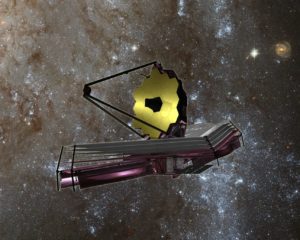Jun
14
Will James Webb Ever Get Off the Ground?
Did you know that the famed Hubble Space Telescope (HST) is going to be replaced?
Well, not “replaced” exactly, since it will probably remain functioning in low Earth orbit for many more years. There will be no direct replacement, as its coverage of near-ultraviolet to near-infrared wavelengths is still quite valuable, and nothing with similar ability is currently in the offing. But, a successor as NASA’s flagship astrophysics mission has been in development for 20+ years: the James Webb Space Telescope (JWST), named after a former NASA administrator who worked on the Apollo progam.

“Very different from a scaled-up Hubble, it is designed to operate colder and farther away from the Earth at the L2 Lagrangian point, where thermal and optical interference from the Earth and Moon are lessened. [Note: The L2 is a gravitationally stable point in space about 930,000 miles (1.5 million kilometers) from Earth.] It is not engineered to be fully serviceable (such as replaceable instruments), but the design includes a docking ring to enable visits from other spacecraft. A main scientific goal of JWST is to observe the most distant objects in the universe, beyond the reach of existing instruments. It is expected to detect stars in the early Universe approximately 280 million years older than stars HST now detects. The telescope is an international collaboration between NASA [with subcontractors like Northrop Grumman], the European Space Agency, and the Canadian Space Agency since 1996, and is planned for launch [from French Guiana] on an Ariane 5 rocket. Although JWST is primarily an infrared instrument, its coverage extends down to 600 nm wavelength light, or roughly orange in the visible spectrum. A typical human eye can see to about 750 nm wavelength light, so there is some overlap with the longest visible wavelength bands, including orange and red light.” (Wikipedia)
The JWST’s primary mirror, made of hexagonal, gold-plated beryllium segments, is roughly 21 feet in diameter. That’s nearly 3x that of the Hubble, and it will be “kept cool by an origami-folded sunshield the size of a tennis court.”
You might be thinking that 20+ years is a long time to bring one project to fruition, and you’re right. NASA is infamous for cost overruns and schedule delays, but the JWST’s history of one problem/delay after another — from technical issues and damaged materials/equipment to mismanagement and personnel changes — might set a new record. (If someone wants to research that, please let us know what you find.)

Originally estimated at $1 billion for a scheduled launch in 2007, JWST was already up to $6.5 billion by Nov. 2010 and in need of a $400 million injection to have any hope of meeting a tentative 2015 launch. In 2011, the launch was re-scheduled for 2018 and the projected cost-cap was $8 billion. In Sep. 2017, officials pushed the date back to 2019, and the cost was already up to $8.8 billion. The following year saw the launch date pushed to May 2020, then March 2021, with an updated cost estimate of nearly $9.7 billion.
According to Thomas Zurbuchen, head of NASA’s science directorate, things have been going great with the project lately. This includes a recent successful test of the system’s Deployable Tower Assembly.
But, he says, the planned launch-date next March is no longer “in the cards”. Why? Not for any of the usual reasons. Blame this delay on — of course — COVID-19 and the ongoing global pandemic.
“JWST is proving to be an exceptionally complex machine to build and test, as it features no less than 300 single points of failure, as Space Policy Online reported earlier this year. The telescope is currently in the integration and testing phase of its development, but the pandemic forced NASA and Northrop Grumman to slow things down. As SpaceNews reports, work did not halt completely at the Northrop facility in southern California; the company is now running five eight-hour shifts each week, as opposed to the usual 12 10-hour shifts.” (Gizmodo)
While a revised launch schedule won’t be assessed until next month, Zurbuchen said, “I’m very optimistic of this thing getting off the launch pad in ’21.”

It is extremely doubtful that the JWST project would be scrapped at this point, given the amount of time and costs already invested. But, it should be noted that there is quite a bit of concern among the American space “community” that the JWST’s ongoing problems, cost overruns, and schedule delays will jeopardize other projects, including the much-anticipated Wide Field Infrared Survey Telescope (WFIRST). The impact will be both budgetary (for obvious reasons) and one of perception. If the powers-that-be (including Congress and the President) don’t think NASA can properly manage such costly astrophysics missions anymore, then they may be postponed or canceled, with funding and attention being shifted to other projects, e.g., the next manned Moon mission.
Personally, I have mixed feelings about that. As much as I’d love to see us get back to the Moon (and beyond?), I think more benefit can probably be had for the money with projects like JWST and WFIRST, primarily in terms of scientific knowledge. I am particularly excited about the apologetic value. As astronomer/apologist Hugh Ross said, “That knowledge undoubtedly will unveil yet even more evidence for the fine-tuning design of the universe that makes the existence of physical life, and human life in particular, possible.” (Here is another relevant article that may be of interest.)















